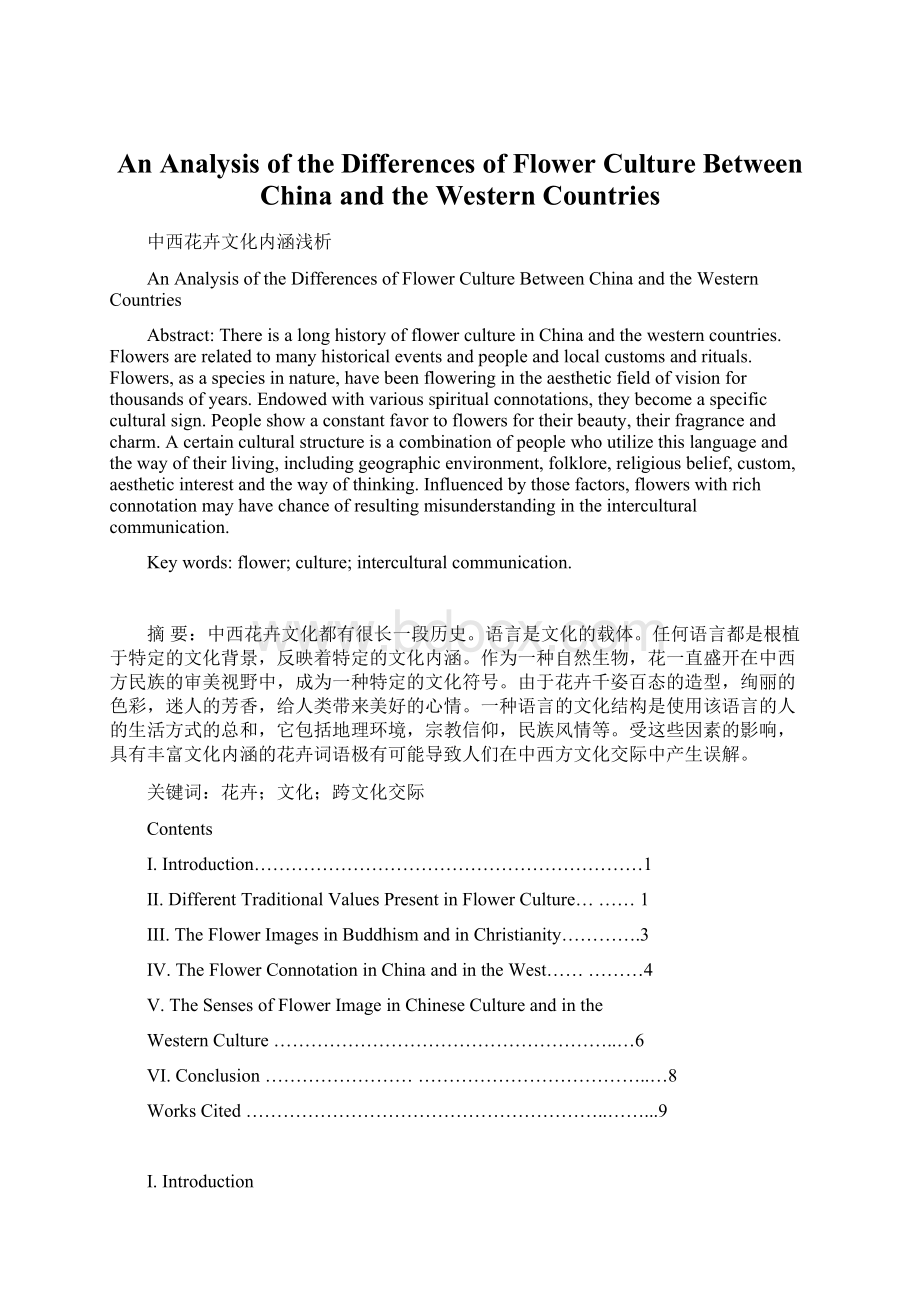An Analysis of the Differences of Flower Culture Between China and the Western CountriesWord格式.docx
《An Analysis of the Differences of Flower Culture Between China and the Western CountriesWord格式.docx》由会员分享,可在线阅读,更多相关《An Analysis of the Differences of Flower Culture Between China and the Western CountriesWord格式.docx(7页珍藏版)》请在冰豆网上搜索。

flower;
culture;
interculturalcommunication.
摘要:
中西花卉文化都有很长一段历史。
语言是文化的载体。
任何语言都是根植于特定的文化背景,反映着特定的文化内涵。
作为一种自然生物,花一直盛开在中西方民族的审美视野中,成为一种特定的文化符号。
由于花卉千姿百态的造型,绚丽的色彩,迷人的芳香,给人类带来美好的心情。
一种语言的文化结构是使用该语言的人的生活方式的总和,它包括地理环境,宗教信仰,民族风情等。
受这些因素的影响,具有丰富文化内涵的花卉词语极有可能导致人们在中西方文化交际中产生误解。
关键词:
花卉;
文化;
跨文化交际
Contents
I.Introduction………………………………………………………1
II.DifferentTraditionalValuesPresentinFlowerCulture………1
III.TheFlowerImagesinBuddhismandinChristianity………….3
IV.TheFlowerConnotationinChinaandintheWest……………4
V.TheSensesofFlowerImageinChineseCultureandinthe
WesternCulture………………………………………………..…6
VI.Conclusion……………………………………………………..…8
WorksCited…………………………………………………..……...9
I.Introduction
BoththeChineseflowercultureandtheWesternflowerculturehavealonghistory.Flowerisofcloserelationshipwithalotofhistoricalpersons,historicalevents,customsandhabits,theweatherandregions,andfashionsandsoon.InChinaandthewesterncountries,flowershavedifferentculturalconnotationsandtheyreflectthedifferencebetweentheirownculturalpsychologyandappreciationofthebeautifulthings.Inthisthesis,wewilltrytochieflypresenttherelationshipbetweenflowersandthetraditionalvalues,religioustales,customsandhabitsaswellaslanguagetraditionsinbothChinaandthewesterncountries.
ThereisalonghistoryofflowercultureinChinaandthewesterncountries.Flowersarerelatedtomanyhistoricaleventsandpeopleandlocalcustomsandrituals.Asweknowthatlanguageisthecarrierofculture,anylanguageintheworldisrootedinpeculiarcultureandbackground,andreflectsculturalconnotation.Flower-relatedwordsareimportantasacomponentofalmostallthehumanlanguageandcarrytheirownconnotations.Flowers,asaspeciesinnature,havebeenflavoringintheaestheticfieldofvisionforthousandsofyears.Endowedwithvariousspiritualconnotations,theybecomeaspecificculturalsign.Peopleshowaconstantfavortoflowersfortheirbeauty,theirfragranceandcharm,andthoseweknownecessarilygenerateacommongroundinconnotationsofflower-relatedwordsbetweenChineseandEnglish.However,everylanguagehasitsownethnicculture.Acertainculturalstructureisacombinationofpeoplewhoutilizethislanguageandthewayoftheirliving,includinggeographicenvironment,folklore,religiousbelief,custom,aestheticinterestandthewayofthinking.Influencedbythosefactors,flowerswithrichconnotationmayhavechanceofresultingmisunderstandingintheinterculturalcommunication.
II.DifferentTraditionalValuesPresentedinFlowerCulture
ThereisaspecialwayofrealizationwhentheChineseappreciateflowers.Chinesepeopleliketoexperienceobjectsthoughtheirspiritsandtheypaymoreattentiontotheintuitionandthepowerofunderstanding.Asisknowntoallofus,Chinesepeopleprefertoadvocatinghuman’sspiritandsoulwhilethewesternpeopleupholdscienceandtechnology,concerningaboutthereason,andmaybeitisbecausethewesternculturehasalwaysbeenaffectedbythescientificthoughtforcenturies.However,theChineseliketotalkabouttheartofexistenceorthepoeticqualityoflife.“ThemaincourseofthewesterncultureisobjectanditisthesocalledscientificculturewhiletheChinesecultureisabouthumanandspirit,anditiscalledartculture”(Qian138).
TheChinesetraditionalphilosophyalwaysemphasizestheunionofthehumanandtheHeavenandtheyemphasizethecloserelationshipbetweenhumanbeingsandthenature.Theyoftenviewthenatureashumanbeingsandhumanbeingsasnature.Asforthecomprehensionofnature,theancientChinesealwaysthoughtthatalltheobjectsofnaturearemadeofthesamecertainfactors,evenwehumanbeingsarealsomadeofthesamecertainfactors,soweoftenhearpeoplesaythattheywanttoreturntothebosomofnature.IntheancientChinesepeople’sopinion,animals,plants,eventhestuffswhichhavenolifeallhavesoul,butatthesametime,humanbeingshavetheintelligence.ThatiswhyChinesepeoplewouldliketheflowerstobetheirfriendsandtheygavedifferentflowersdifferentconnotations,suchas,orchidisnoble,plumblossomhasthehighspiritofstrugglingwiththecold,andlotus“iscleanevenbornoutoftheooze”.Asamatteroffact,whilepeopleappreciatetheflowers,theyareappreciatingtheinnerqualityofhumans.
Relativelyspeaking,thewesterntraditionalthinkingisbasedonthecognitionofthenature,theythoughtonlywhentheyunderstandthenature,theycanmasterit;
aslongastheyexplorethenaturewell,theycanconquerit.Thewesternpeoplelaystressonthescientificthinkingtraditionsandtheypayattentiontotheessencewhentheymastersomething,andtheyattachimportancetotheobjective,theyalwaysanalyzeandreasonnatureasitisanobject.Itisverycleartothemforwhatisobjectiveandwhatissubjective,whatinnerworldisandwhatouterworldisandtheycanreasonablydistinguishhuman’ssensefromtheoutsideworld.Anywayhumanisalwaysoutstanding.Thus,whenthewesternpeopleappreciateflowers,theyoftentakeflowersassomekindofsymboltoexpresstheirfeelingsoftheirideas,forexample,JohnWordsworth’spoemIWanderLonelyasaCloud:
IWanderLonelyasaCloud
Thatfloatsonhigho’ervalesandhills,
WhenallatonceIsawacrowd,
Ahost,ofgoldendaffodils;
Besidesthelake,beneaththetrees,
Flutteringanddancinginthebreeze(Wu19).
Thebeautyofnatureispresentedbythelovelyandexuberancedaffodilsandthebeautifulflowersmakethepoethappy.So,wecanseethattheChineseandthewesternpeoplehavedifferentopinionsabouttherelationshipbetweennatureandhumanbeingswhileappreciatingflowers.Basesonthisopinion,theChinesewillthinkithastheunyieldingcharacterwhentalkingaboutpine,andthinkithasthecharacterofcleanandhonestwhentalkingaboutlotus,therealfriendshipwhentalkingaboutbegonia;
whiletothewesternpeople,theythinkindifferentways.Theythinkthatpinestandsforpity;
lotusstandsforestrangedlove;
andbegoniastandsfordeformity.Itisobviousthatwecanhardlyfindanyrealrelationbetweenhumanbeingsandtheflowers.
III.TheFlowerImagesinBuddhismandinChristianity
TheChineseflowercultureisdeeplyinfluencedbytheChineseprofoundspiritualculture,suchasfolkbeliefsofdifferentdynasties,thethoughtoftheTaoistschoolandthethoughtoftheConfucianschool,mostlytheBuddhismthatcamefromIndia.
FlowerandBuddhismhavedeeprelationshipinhistory.Intheclassicalnovel,ThePilgrimagetotheWest,Ru-laiandKwan-yinarealwayssittingonthecushionmadeoflotus.AccordingtotheBuddhistScripture,whenSakyamuni—thefatherofBuddha—wasborn,alltheflowersareblossomingatthesametime,especiallythelotuseswhichliveinthepondsuddenlycameintobloomanditisasbigastheupperpatofacarriage(Zhou253).ItissaidthatthemostpopularBuddhaidol—Kwan-yinwasalsobornoutofalotus.Becausethelotus’sloftycharacter“cleanandhonesty”issimilarwiththeBuddhismidea“freefromvulgarity”.WhentheBuddhismcametoChina,peoplenaturallyhaveatheartthelotuswhenreferringtotheBuddhaislotusandlotusisBuddha.LotusbecomesasymbolofBuddhism.
Thewesternreligiousculturehasmanyallusionswhichrelatetoflowers,especiallyChristianity’smostimportantbook—theBible.Inthisbook,rosehastheclosestrelationwiththeChristianity.AccordingtotheliteraryquotationintheBible,thebirthofChristopensthedoorofatoningforhispeople’scrime,whichiswhymanyrosesbloomonthelandofabundance.What’smore,whiterosesuggestspureandvirgin,andsymbolizeChrist’smother—SaintMary,whileredrosemeansblood,deathandthesufferingofcrucifixionChristbear.
TheoriginalreligionofChinaortheWestistheworshipofthenature.Peoplepersonifythepowerofnatureandthephenomenaofnatureandtheyrespectnatureasgod.IntheancientChina,humanbeingsandthenaturehasanoriginalsincererelationandthefolktalesabouthumanmixtogetherwiththefolktalesaboutnatureandallkindsofnaturalphenomenabecomethemostwonderfulcarrierofvarioustalesorlegends.Flowers,asthequintessenceofallthingsonearth,ofcourse,haveitsrelatedtales.TheChinesehaveflowertalesinourlegendsstories,forinstance,“NvYi”istheflowergodoftheancientChina.IntheWest,theancientGreeceandRomanpeopleendowedhuman’sspiritwithnature.Theyhaveflowergods,too,suchasFloraandArtemis.
IV.TheFlowerConnotationinChinaandintheWest
InboththeChineseandwesternculture,flower